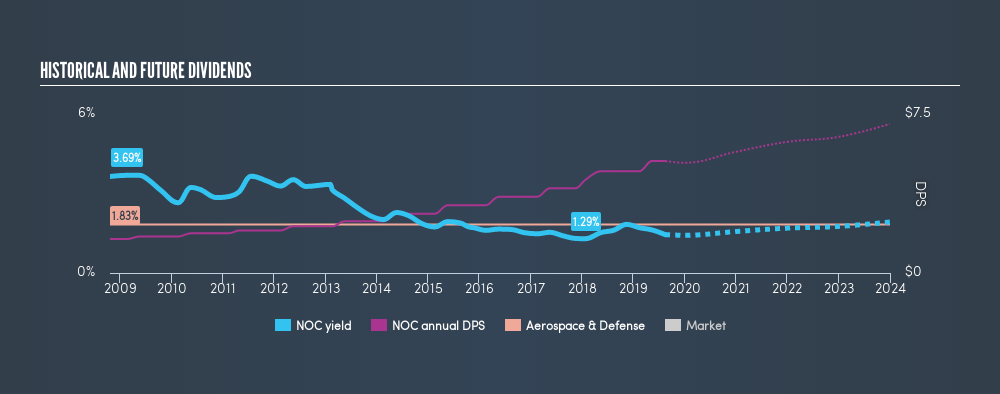- United States
- /
- Aerospace & Defense
- /
- NYSE:NOC
What To Know Before Buying Northrop Grumman Corporation (NYSE:NOC) For Its Dividend

Could Northrop Grumman Corporation (NYSE:NOC) be an attractive dividend share to own for the long haul? Investors are often drawn to strong companies with the idea of reinvesting the dividends. If you are hoping to live on the income from dividends, it's important to be a lot more stringent with your investments than the average punter.
While Northrop Grumman's 1.4% dividend yield is not the highest, we think its lengthy payment history is quite interesting. The company also bought back stock during the year, equivalent to approximately 2.5% of the company's market capitalisation at the time. Some simple research can reduce the risk of buying Northrop Grumman for its dividend - read on to learn more.
Click the interactive chart for our full dividend analysis

Payout ratios
Dividends are usually paid out of company earnings. If a company is paying more than it earns, then the dividend might become unsustainable - hardly an ideal situation. As a result, we should always investigate whether a company can afford its dividend, measured as a percentage of a company's net income after tax. Looking at the data, we can see that 25% of Northrop Grumman's profits were paid out as dividends in the last 12 months. A medium payout ratio strikes a good balance between paying dividends, and keeping enough back to invest in the business. Besides, if reinvestment opportunities dry up, the company has room to increase the dividend.
Another important check we do is to see if the free cash flow generated is sufficient to pay the dividend. Of the free cash flow it generated last year, Northrop Grumman paid out 33% as dividends, suggesting the dividend is affordable. It's encouraging to see that the dividend is covered by both profit and cash flow. This generally suggests the dividend is sustainable, as long as earnings don't drop precipitously.
Is Northrop Grumman's Balance Sheet Risky?
As Northrop Grumman has a meaningful amount of debt, we need to check its balance sheet to see if the company might have debt risks. A rough way to check this is with these two simple ratios: a) net debt divided by EBITDA (earnings before interest, tax, depreciation and amortisation), and b) net interest cover. Net debt to EBITDA measures total debt load relative to company earnings (lower = less debt), while net interest cover measures the ability to pay interest on the debt (higher = greater ability to pay interest costs). With net debt of 2.56 times its EBITDA, Northrop Grumman's debt burden is within a normal range for most listed companies.
Net interest cover can be calculated by dividing earnings before interest and tax (EBIT) by the company's net interest expense. Northrop Grumman has EBIT of 7.83 times its interest expense, which we think is adequate.
Dividend Volatility
From the perspective of an income investor who wants to earn dividends for many years, there is not much point buying a stock if its dividend is regularly cut or is not reliable. For the purpose of this article, we only scrutinise the last decade of Northrop Grumman's dividend payments. During this period the dividend has been stable, which could imply the business could have relatively consistent earnings power. During the past ten-year period, the first annual payment was US$1.60 in 2009, compared to US$5.28 last year. This works out to be a compound annual growth rate (CAGR) of approximately 13% a year over that time.
With rapid dividend growth and no notable cuts to the dividend over a lengthy period of time, we think this company has a lot going for it.
Dividend Growth Potential
While dividend payments have been relatively reliable, it would also be nice if earnings per share (EPS) were growing, as this is essential to maintaining the dividend's purchasing power over the long term. Strong earnings per share (EPS) growth might encourage our interest in the company despite fluctuating dividends, which is why it's great to see Northrop Grumman has grown its earnings per share at 18% per annum over the past five years. A company paying out less than a quarter of its earnings as dividends, and growing earnings at more than 10% per annum, looks to be right in the cusp of its growth phase. At the right price, we might be interested.
Conclusion
Dividend investors should always want to know if a) a company's dividends are affordable, b) if there is a track record of consistent payments, and c) if the dividend is capable of growing. Firstly, we like that Northrop Grumman has low and conservative payout ratios. Earnings per share have not been growing, but we respect a company that maintains a relatively stable dividend. Overall, we think there are a lot of positives to Northrop Grumman from a dividend perspective.
Companies that are growing earnings tend to be the best dividend stocks over the long term. See what the 16 analysts we track are forecasting for Northrop Grumman for free with public analyst estimates for the company.
We have also put together a list of global stocks with a market capitalisation above $1bn and yielding more 3%.
We aim to bring you long-term focused research analysis driven by fundamental data. Note that our analysis may not factor in the latest price-sensitive company announcements or qualitative material.
If you spot an error that warrants correction, please contact the editor at editorial-team@simplywallst.com. This article by Simply Wall St is general in nature. It does not constitute a recommendation to buy or sell any stock, and does not take account of your objectives, or your financial situation. Simply Wall St has no position in the stocks mentioned. Thank you for reading.
About NYSE:NOC
Northrop Grumman
Operates as an aerospace and defense technology company in the United States, the Asia/Pacific, Europe, and internationally.
Undervalued established dividend payer.
Similar Companies
Market Insights
Community Narratives





